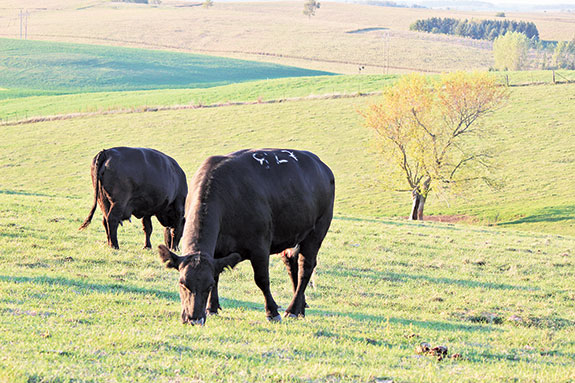With calves no longer at their sides, and the next calf only utilizing limited resources in the second trimester, cows can more easily utilize nutrients to move back to an ideal body condition score (BCS) of 5.5 to 6 on a nine-point scale.
To regain this condition though, cows must be fed properly.
Though cows’ requirements are typically lower in the autumn, pasture quality is often also decreasing. To compensate for this lull in pasture performance, producers are encouraged to supplement the pasture, corn stalks or stored forages with a protein and mineral supplement.

Timing of supplementation is crucial. If the supplement is put out too late, the herd may start to experience deficiencies before problems are noticed.
Low-quality pastures may also be overgrazed if enough nutrients are not supplied.
Providing supplementation beginning in late summer or early autumn can help extend the pasture because cows will require less forage to fill their requirements.
Producers tend to run into problems when guessing when the cow needs supplementation. Estimations are often too late, and problems may have already started to occur. Typically, the cow knows better than we do when she needs additional nutrients.
For this reason, placing a supplement in the pasture early in the season will allow cows to consume the requirements they need when they need them.
Producers have two primary options for supplementation: limit feeding and ad libitum, or free-choice, supplementation. Limit feeding can be difficult as some cows will consume higher levels than others, and producers must then estimate the amount of supplementation needed.
Ad libitum feeding allows cows to consume supplementation when needed. Ad libitum supplementation is possible with products that include intake-management ingredients, such as intake-modifying technology. This type of technology addresses overconsumption.
When supplements include intake-management ingredients, cows return to the supplement feeder and snack throughout the day.
Routine consumption throughout the day works well because microbes in the rumen are continuously digesting and need the supplied protein to help break down nutrients at all times.
Intake-management ingredients were created to accomplish this goal. When included in the supplement, these ingredients send signals to the cow, helping to tell her to only consume what she needs at that time. She then returns to the meal, liquid, block or tub for additional supplement when needed.
Without intake-management ingredients in the supplement, cows may overconsume protein due to the high palatability of these supplements. Overconsumption can be costly and may lead to toxicity issues; therefore, intake-management ingredients are key for ad libitum supplementation.
Producers have several options for protein and mineral supplementation. Here are a few of the options, feeding strategies, benefits and drawbacks of each:
- Cubes and cakes: These products are a hand-fed protein source where producers must estimate the level to feed. Though cubes and cakes are typically the cheapest per unit of protein, it’s the eye of the feeder that controls the amount fed to the cows, resulting in significantly more labor. In addition, higher levels of shrink due to weather are probable as this product form is often fed directly onto the ground.
-
Liquid supplements: This product type is the next above cubes and cakes in price. Liquid supplements without intake-management ingredients must be limit-fed to avoid overconsumption. Wheel feeding or pouring onto bales can also help limit intake; however, consumption levels will especially increase if pasture quality or quantity is low.
With liquid supplementation, a recommended feeding plan is to supplement early in the season, make sure adequate forage is available and then use a product with intake-management ingredients to help prevent overconsumption. -
Intake-modified meal supplements: This supplement form is typically more expensive than liquid supplements in base price, but when used properly, the cost tends to balance per nutrients consumed per cow. As with the first two options, producers must manage meal supplements based on pasture quality and quantity. Cows grazing pastures with low quantities of forage may experience high intake levels of meal supplements.
For example, a producer that is targeting 3 pounds per day of supplement may have a difficult time meeting that level if grass quantities decrease. In this case, the cows may increase consumption to 6 to 10 pounds of meal supplement per day to meet their energy needs.
With intake-managed meal supplements, the quantity of forage dictates the level of supplement the cows eat, so the producer must control intake by the quantity of forage available. - Conventional poured tubs: Poured tubs provide high levels of energy to cows; however, high palatability and moisture levels may make it difficult to modify intake. As pasture quantity decreases and cows’ nutrient requirements increase, consumption may rise, resulting in increased costs.
- Cooked molasses or low-moisture tubs: This product form can be economical because it is designed to prevent cows from overconsuming the supplement. Though there are high levels of molasses in the product, the dense product form encourages cows to only eat small amounts throughout the day.
- Cows eat somewhere between 0.5 to 1.25 pounds per day when allowed free choice to cooked-molasses tubs – even with decreased pasture levels. If additional energy is needed, extra energy sources must be provided.
-
Intake-modified poured blocks: Similar to cooked-molasses tubs, poured blocks with intake modifiers control intakes well, helping cows to only consume the levels they require.
The difference is that these poured blocks provide a total balanced supplement which allows cows to consume additional calories to help them regain condition. These blocks are available in various sizes up to 500 pounds to fit different feeding systems and reduce the labor of feeding.
These total-balanced poured blocks can be a good option for producers that need to supply more calories to the cow in the fall. The blocks can help cows regain body condition while extending forages. Because of the additional calories, this option is not only a supplement but also can serve as part of a substitution strategy for low-quality pasture.
Which option is right for you?
When deciding the supplement product form for your herd, evaluate your capabilities, forage quality, quantity and herd goals.
Larger herds may have challenges with the amount of cubes or tubs they need to feed and may find value in liquid, while herds in colder climates may prefer meal supplements or cooked-molasses tubs compared to feeding liquid that could freeze.
If ad libitum feeding cooked- molasses and intake-modified meal, liquid or poured blocks work well because of their controlled intake capabilities.
With these systems, cows return several times throughout the day for snack meals rather than one large meal, helping the rumen bacteria to be fed often and more consistent digestion to occur.
Options without intake-management ingredients may cause cows to stay near the feeder throughout the day rather than grazing and must be closely monitored by the producer.
Whichever supplementation option is chosen, early season or year-round supplementation is typically the best option.
By making supplements available to cows before deficiencies occur, cows are better able to maintain body condition through all seasons. Well-conditioned cows have a greater potential to birth healthy calves, wean more marketable pounds and breed back quicker.
In addition to performance benefits, placing supplements in the pasture before deficiencies occur may actually lower overall intake in the long run because cows will have a greater potential to maintain condition through all seasons.
For optimal results, work with your nutritionist to determine a supplementation option that best meets the requirements of your herd and the goals of your operation. ![]()
References omitted due to space but are available upon request. Click here to email an editor.
PHOTOS
TOP: Cattle producers have several product options for supplementing pastures and stored forages. Intake-management ingredients, found in the poured blocks in this photo, allow supplements to be fed free-choice because the ingredient helps cows to only consume the nutrients they require.
BOTTOM: Fall is the most economical time to help spring-calving cows regain body condition. Supplying supplements to cows in the fall can help them return to an ideal body condition score of 5.5 to 6 on a nine-point scale, helping to prepare them for the winter and the next calving season. Photos courtesy of Purina.

Field Cattle Consultant
Purina Animal Nutrition






